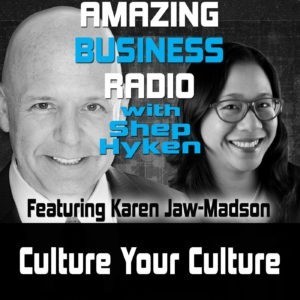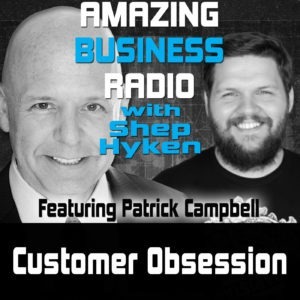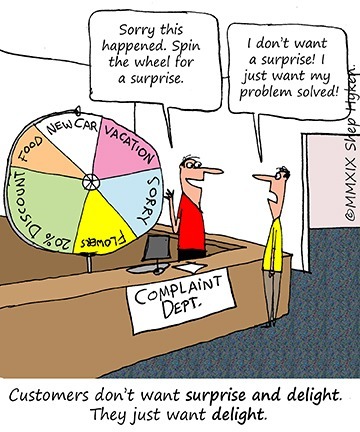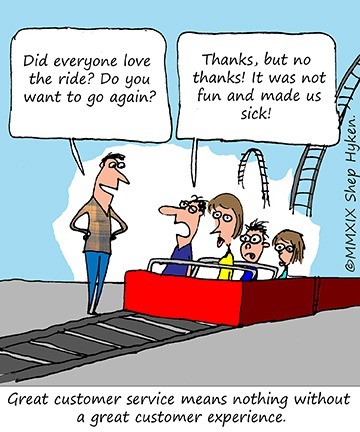Shep Hyken's Blog, page 127
May 8, 2019
Don’t Be Lazy – Go the Extra… Inch!
 The other night my wife and I met three other couples for dinner at a nice restaurant. The food was great, but the service ended on a sour note. Our server got lazy. His attitude toward the end of our experience reminded me that sometimes people don’t do what is requested – or even expected – simply because they don’t want to make the little extra effort to take care of their customers. Let me share what happened.
The other night my wife and I met three other couples for dinner at a nice restaurant. The food was great, but the service ended on a sour note. Our server got lazy. His attitude toward the end of our experience reminded me that sometimes people don’t do what is requested – or even expected – simply because they don’t want to make the little extra effort to take care of their customers. Let me share what happened.
At the end of the evening, the server asked if we would like to split the check four ways. That’s how I typically do it – just divide the check by four. However, one of my friends had a special request. He said, “I ordered some expensive drinks and an extra appetizer, so I’m sure my portion was more than the others. Would you mind splitting up the check based on what we ordered?”
The server thought about it and said, “I would, but I can’t remember who ordered what.” Then he added, “By the way, for parties of eight or more there’s an automatic 18% gratuity added.”
Now, I didn’t mind how the check was split, but I did mind how he responded to my friend’s request. He remembered well enough to make sure that the right person received the right salads, appetizers, main courses, and drinks. How could he suddenly claim amnesia?
My wife knew right away what was going through my mind, and I knew what was going through hers. She was praying that I wouldn’t say anything, and I didn’t.
But here I am today, still thinking about what happened. It was obvious to me that the server was too lazy to take a few extra minutes to split up the check. It was a slow Monday night, so time wasn’t an issue. He just chose not to do it.
Honoring an inconvenient request is one thing, and probably not expected. But doing something small that takes little or no extra effort should not be a big deal – especially when you’re depending upon a nice gratuity for the effort. But, even that shouldn’t matter.
One of the nicest expressions of appreciation to a customer is giving them a little extra time. Sometimes it’s time on the phone to explain something. Sometimes it’s spending a few minutes building rapport and a better relationship. And sometimes it’s just doing a little math to split up a check.
The point is, don’t be lazy. Don’t take the easy way out. You don’t necessarily have to go the extra mile, but consider going the extra inch. It’s almost always noticed and appreciated.
Shep Hyken is a customer service expert, keynote speaker, and New York Times bestselling business author. For information, contact 314-692-2200 or www.hyken.com. For information on The Customer Focus customer service training programs, go to www.thecustomerfocus.com. Follow on Twitter: @Hyken
customer service training programs, go to www.thecustomerfocus.com. Follow on Twitter: @Hyken
The post Don’t Be Lazy – Go the Extra… Inch! appeared first on Shep Hyken.
May 7, 2019
Amazing Business Radio: Karen Jaw-Madson
 Culture Your Culture
Culture Your Culture Making Customers the Focus of Your Company and its Culture
Shep Hyken interviews Karen Jaw-Madson. They discuss her company, Design for Work Experience; her book, Culture Your Culture; and the most effective work cultures for customer service.








In Shep’s opening monologue, he talks about the difference between a repeat customer and a loyal customer.
The Interview with Karen Jaw-Madson:
Karen’s book, Culture Your Culture, is intended as a step-by-step how-to guide for organizations looking to design, customize, and sustain their company culture.
It’s important to plan your culture with intention rather than letting it happen by accident. Customization also needs to happen instead of copying what other companies have done; culture is nothing without contextual framework. Culture must be intentional and relevant to its intended context.
Companies must do three things to hone their culture. First, they must practice organizational mindfulness—i.e., pay honest attention to what’s in front of them at all points of the process. They must have a willingness to follow through on processes. Finally, and most importantly, they must actually change.
Changes need to be implemented consistently for companies to get “good”. Organizations need to commit to ongoing behaviors, mindsets, and processes in order to see results.
Organizational leaders must demonstrate the changes they wish to see implemented. Culture starts at the top and is felt throughout the whole company and then by the customers.
Treat customers as a part of the company, an internal force. The best customer service cultures are flexible, people-centered, and consistent. Remember: we’re all
Think about your company’s top goal and priority for culture, and imagine potential consequences if nothing were to change in one year’s time. Let that drive your commitment to change and develop your company-wide culture.
Quotes:
“Don’t allow your culture to be a potential liability as opposed to a differentiating asset” – Karen Jaw-Madson
“To the leaders: how do you expect employees to get behind what you’re trying to do if you’re not modeling it yourself?” – Karen Jaw-Madson
“Give your customers a seat at the table and treat them as an important component of the process. Go to where they are and embed yourself in their daily lives.” – Karen Jaw-Madson
“See customers as co-designers of the mission of your company.” – Karen Jaw-Madson
About:
Karen Jaw-Madson is an organizational expert and versatile leader across multiple fields. She is principal of Co.-Design of Work Experience and the author of Culture Your Culture: Innovating Experiences at Work.
Shep Hyken is a customer service and experience expert, New York Times bestselling author, award-winning keynote speaker, and your host of Amazing Business Radio.
This episode of Amazing Business Radio with Shep Hyken answers the following questions … and more:
How can I turn a repeat customer into a loyal customer?
How can I earn my customers’ loyalty?
How can I change my company’s culture?
How is the employee experience related to the customer experience?
The post Amazing Business Radio: Karen Jaw-Madson appeared first on Shep Hyken.
May 6, 2019
5 Top Customer Service Articles for the Week of May 6, 2019
Each week I read a number of customer service and customer experience articles from various resources. Here are my top five picks from last week. I have added my comment about each article and would like to hear what you think too.
4 Reasons Customer Service Ratings Matter More Thank You Think by Team Support
(Team Support) Feedback matters in the customer-centric era of business we work in. Whether it’s a customer telling your CEO that an agent did a great job or giving them a “negative” face after a chat session, there are many ways companies can receive feedback about their business.
My Comment: Ratings are important, and for more reasons you might think. While ratings are important to validate the company is doing a good job and public ratings help sell, there is more. Ratings can actually help attract good employees.
7 Ways to Retain Customers’ Trust and Build Up Brand Loyalty by Mike Kappel
(Business2Community) Trust can make or break the success of your business. How do you retain customers’ trust?
My Comment: If you’ve been following this recap on a regular basis, then you know I like lists. Lists are usually about “how to’s.” Well, here is a list to remind us of some of the basic tactics in customer service. If you want loyal customers, here are some reminders (seven of them) about how to go about it.
5 Reasons Why Mobile App is More Than a ‘Nice to Have’ for Small Businesses by Sagar Sharma
(Entrepreneur India) 70% cent of consumers expects a personalized experience from brands and a mobile app is the perfect way to personalize communications with your customers.
My Comment: Does your business have an app? If not, here are some compelling reasons to have one. And, even though the emphasis of the article is on small businesses, this can work for any type of business. An app can enhance customer engagement customers, create a personalized experience and influence loyalty.
How Customer Service Needs to Evolve in the Subscription Economy by Wendy Shlensky
(CustomerThink) Customer service is a true differentiator in today’s ever-growing subscription economy. What started with newspaper and magazines has now evolved to real-time, contextual and personalized product ownership experiences.
My Comment: The subscription model is important to virtually any business. For many organizations and industries, this is a new way to think in terms of sales, loyal customers and more. Here’s a great article to remind us of the basics of the subscription model, why it works, and how it can work for you.
A High School Principal Put a Laundromat in His School. It’s a Customer Success Lesson You Shouldn’t Miss by Sonia Thompson
(Inc.) Customer success is limited when that person’s challenges are compartmentalized.
My Comment: Here is a story about a high-school principal that put a free laundromat in the school for the benefit of the students. Even though it’s a high school, and the “customers” are his students, it is a great story about how to think about the perks we give our employees.
Shep Hyken is a customer service expert, professional speaker and New York Times bestselling business author. For information on The Customer Focus customer service training programs go to www.TheCustomerFocus.com. Follow on Twitter: @Hyken
customer service training programs go to www.TheCustomerFocus.com. Follow on Twitter: @Hyken
The post 5 Top Customer Service Articles for the Week of May 6, 2019 appeared first on Shep Hyken.
May 3, 2019
Guest Blog: Why Convenience is a Key Differentiator in CX
This week we feature an article by Jaime Bailey who writes about how important convenience has become to the customer experience and how it is a necessity for providing a competitive edge in today’s marketplace.
As has been widely documented, the balance of power in today’s marketplace has shifted away from the town square and to the customer. This shift is largely due to the digital transformation that has disrupted our entire society over the past quarter-century, and the mantra of maximizing the customer experience has grown directly out of that transformation.
No matter how big your company is today, or how well your brand is faring, it’s a fact that you always have room to improve your relationship with your customers. And the latest area widely touted to provide a competitive edge in the customer experience is convenience.
Easy: The New Loyalty
One effect of the digital transformation has been the erosion of the traditional definition of brand loyalty. After all, it’s a lot harder to retain your customers when their selection pool has gone from four similar products at the local department store to 400 products worldwide that they can see without leaving their couch. In fact, the results of a recent UK study could be summarized as “easy is the new loyalty”:
50 percent of respondents said that loyalty is a thing of the past.
74 percent said they will do repeat business with a company if their experience is easy.
Customers who find their interactions are easy are 40 percent less likely to churn.
Similarly, as far back as 2011, RightNow’s 2011 Customer Experience Impact Report found that 55 percent of consumers said that easy access to support and information can make them fall in love with a brand.
In short, the bar for customer convenience has been set on high, even if your brand is not blatantly offering convenience (like a fast-food chain does, for instance). Any company that can offer a customer experience more convenient than its competitors is poised to prosper.
CX for Busy Lives
When considering why convenience has become a key differentiator, the answer is right in our faces: We all have busy lives; we’re all pulled in multiple directions all day long. Given an alternative, does anyone want less convenience or to spend more time on their to-do list?
This idea isn’t really new. Corner markets and convenience stores aren’t just competing with the big-box superstores, they flourish. Why? The reason is in their names: They’re right where their customers are, and they’re convenient. They don’t usually have lines, and they don’t have aisles and aisles of choices to sift through. They’ve established just what their shoppers want to be able to run in and grab, be it a hot snack, a cold drink, or gas for the car and ice cream for the kids.
Taking this one step further, let’s consider the downside of limitless choices. In a quick and convenient customer experience, the customer doesn’t want to wander around, get lost or distracted, or hit a dead-end on their way to achieving their goal for the transaction; in fact, getting in and out easily with exactly what they need is an integral part of the goal.
The industry disruptors like Amazon are the ones who latch onto this reality and work to not only be proactive and easy on their customers today but to look ahead and implement what will be quick and convenient tomorrow. For instance, the most effective chatbots are programmed to recognize when a customer is struggling and to effortlessly deliver that customer to a live customer service agent.
Changing your approach so that each part of the customer experience is created around your customers’ definition of what is convenient is what creates loyalty today. Have you gone through your own company’s customer journey recently? If you were a customer, would you feel your company is easy to do business with?
Become More Convenient
Here are some ideas for improving the convenience of your CX:
As referenced above, clear a path to the purchase. Don’t over-recommend or require extra clicks and keep your buying process simple.
Be where your customers are. Many companies are exploring selling opportunities through social media like Instagram, where they can post pictures and provide links to quick payment options like Paypal; other companies are opening up tools like WhatsApp for their customer support and live chat.
Convenience for the customer means flexibility in your staff. Improve employees’ listening skills and empower them to follow through.
Recognize that customer convenience simply can’t exist within siloed processes. Build interdisciplinary teams and make it easy for your customers to reach them.
Today’s customer is deeply sensitive to any stumbling block around getting help when they need it. Ensure that your online FAQs are easy to find and current; employ an omnichannel solution to seamlessly connect any customer from any channel directly to a live agent with only one click.
On a related note, launch a callback solution to give your customers control over their time instead of waiting in a call queue. Callback allows them to “save their place in line” and get a call when an agent is available or schedule a call at a time most convenient to them.
 Jaime Bailey is the Vice President of Marketing at VHT. With more than 16 years of experience, she stewards a team focused on understanding the customer experience, applying new marketing techniques, and maximizing ROI. A devout proponent of the importance of a well-crafted marketing strategy, Jaime’s efforts have helped companies enrich customer relationships, drive revenue, and grow brand equity.
Jaime Bailey is the Vice President of Marketing at VHT. With more than 16 years of experience, she stewards a team focused on understanding the customer experience, applying new marketing techniques, and maximizing ROI. A devout proponent of the importance of a well-crafted marketing strategy, Jaime’s efforts have helped companies enrich customer relationships, drive revenue, and grow brand equity.
For more articles from Shep Hyken and his guest contributors go to customerserviceblog.com.
Read Shep’s latest Forbes article: How To Earn A Perfect Customer Satisfaction Score
The post Guest Blog: Why Convenience is a Key Differentiator in CX appeared first on Shep Hyken.
May 1, 2019
Customer Service and CX Lessons from Three Iconic Brands
I’ve talked and written about the differences between customer service and the customer experience, also known as CX. Customer service is typically what transpires between people throughout the buying process or when there is a problem. That’s part of the customer experience, but there is much more to CX than service. It’s the entire journey, from the moment a customer thinks about doing business to any and every interaction point, whether it’s in person, on a digital channel, or with the product. Here are a few examples from companies you know and have likely done business with, thereby experiencing both their customer service and experience.
Amazon: Undoubtedly one of the easiest companies to do business with, this company delivers a CX that creates confidence at every level. They have transparency in pricing by actually informing you of other retailers that have lower prices. They give you confirmation of your order, tracking information, and much more. When you need support, there are good self-service options. Jeff Bezos, the company’s founder, has a relentless focus on creating customer convenience.
Apple: They are masters at engaging their customers at almost every level. Some of their customers are so enthusiastic about the Apple experience that they are referred to as evangelists. People love their Apple products. They have good customer service. Their Genius Bar is… genius. I want to include them in this list not only because of their service. It’s their focus on the entire experience that sets them apart. Just opening the box of an Apple product is an incredible customer experience.
Ace Hardware: I love this company so much I featured them throughout an entire book . This is one of America’s most iconic brands. In recent years they’ve gone head to head with big box stores. They come into town and build a store just down the street, and sometimes directly next door. The big boxes have a greater selection, have lower prices, often spend 30 times plus in advertising dollars, and more. How does Ace Hardware compete? Two ways. First, they deliver amazing service. More than the typical friendly service that’s expected, they provide helpful service. That’s actually their brand promise: “The Helpful Hardware Place.” Then, they add an experience that includes a smaller store that’s easier to navigate inside and rock-star parking with much smaller lots where everyone gets a good space. Plus, there are knowledgeable employees who don’t just answer questions about what the customer is buying, but who can advise about an entire project. Their customer service and experience has helped them survive and thrive in the David versus Goliath competition created by the big-box stores.
So you see, customer service and customer experience are related concepts, but they are not the same. It’s the classic “a square is a rectangle but a rectangle is not a square” scenario; customer service is part of the customer experience, but the latter encompasses so much more. And you need both to succeed. Your product can be the best product in the world, and your customer service may be satisfactory or even good. But without the complete package, sooner or later you will be overshadowed by a company like the ones above whose entire CX is… Amazing.
Shep Hyken is a customer service expert, keynote speaker, and New York Times bestselling business author. For information, contact 314-692-2200 or www.hyken.com. For information on The Customer Focus customer service training programs, go to www.thecustomerfocus.com. Follow on Twitter: @Hyken
customer service training programs, go to www.thecustomerfocus.com. Follow on Twitter: @Hyken
The post Customer Service and CX Lessons from Three Iconic Brands appeared first on Shep Hyken.
April 30, 2019
Amazing Business Radio: Patrick Campbell
 Customer Obsession
Customer ObsessionSubscribing to the Customer Relationship to Win in Business
Shep Hyken interviews Patrick Campbell. They discuss subscription models, company culture, hiring right, and becoming “customer-obsessed.”








In Shep’s opening monologue, he talks about innovative ways to use a subscription model to enhance your business.
The Interview with Patrick Campbell:
Any and every company should consider implementing a subscription model. It brings the relationship with the customer to the forefront and ties it directly to company profit, which has been the trend since the beginning of business.
Subscription is the future of business regardless of industry. It creates more convenience for your customers and generates a steady source of income for your business.
Companies who nurture and prioritize their relationships with their customers are more likely to succeed and win in business. Companies need to build a culture that is “customer-obsessed.”
The two major factors in success are hiring and culture. Culture begins with good hiring; everyone needs to be on the same page so that culture can permeate through the whole business. What’s felt by employees on the inside of a business will be felt by customers on the outside.
It can be difficult to hire the right people, but you must prioritize this. Seek employees who are “obsessed with the pursuit of truth.” This means they will be less arrogant, more driven, and more open-minded—all important qualities that will spell out success for your business.
Having a relationship with your customers gives you a competitive edge. It grants you a better understanding of what customers want, what they need, and what they value. In an increasingly competitive environment, this can either make or break your company; more often than not, “whoever gets closest to the customer wins.”
Quotes:
“Hiring and culture are the things that make or break your company.” – Patrick Campbell
“Your company becomes the product more so than the actual thing you’re selling.” – Patrick Campbell
“Whoever gets closest to the customer wins.” – Patrick Campbell
About:
Patrick Campbell is the co-founder and CEO of ProfitWell (formerly Price Intelligently). Previously, he has worked at Strategic Initiatives, Google, BridgeBright, and the United States Department of Defense.
Shep Hyken is a customer service and experience expert, New York Times bestselling author, award-winning keynote speaker, and your host of Amazing Business Radio.
This episode of Amazing Business Radio with Shep Hyken answers the following questions … and more:
How do I hire the right people?
How do I create a culture that is “customer-obsessed?”
How can I set my business apart?
How can I use a subscription model?
Why is subscription so important?
The post Amazing Business Radio: Patrick Campbell appeared first on Shep Hyken.
April 29, 2019
5 Top Customer Service Articles for the Week of April 29, 2019
Each week I read a number of customer service and customer experience articles from various resources. Here are my top five picks from last week. I have added my comment about each article and would like to hear what you think too.
Your Most Important Business Success Metric? Customer Loyalty! by Chad Storlie
(Franchising.com) Marketers are besieged with metrics. ROI, website visits, website return visits, shopping cart abandonment rates, and average customer spend are all important and well-used metrics to evaluate the success of a business. Everyone agrees metrics are vitally important. What no one can agree on is which metrics are the most important. Until now.
My Comment: I’ve always preached that one of the most important (if not the most) statistics in business is if the customer comes back, and that is the focus of this article. By the way, I like the simple definition the author uses for customer loyalty: “… the ongoing instance of a customer who continues to repurchase from a business when they have competitor and substitute offers available.”
Retailers! Are you putting Customer Experience theory into practice? by Daniel Frank
(TruRating) Over the last three months, we’ve been speaking to some of the best minds working in the field today. Here’s a selection of tips for anyone looking to close the gap between the theoretical and the actual operationalization of customer experience best practices.
My Comment: This article starts with the important finding from Bain and Company stating that 80% of businesses believe that they provide a “superior proposition” (customer service), yet only 8% of their customers agree. That stat is a little old, but there is still a lot of truth to it. The gap between perception and reality, where reality is the customer experience, is still wide for many businesses. The goal is to turn CX theory into CX reality.
Want World Class Customer Service? Add Kindness And Trust by Larry Stuart
(Forbes) Don’t fill roles with just anyone who can fog a mirror. Take your time and find the right person and don’t settle.
My Comment: What goes into creating a world class customer experience? Everything has to work plus “kindness and trust.” The author, Larry Stuart, makes a compelling argument that trust plays a big role in CX – and trust doesn’t start with the customer. It starts with employees. Trust them (as in empower them) to do the job they were hired to do. And, when that trusted employee is empathetic and kind to their customers, you have a winning combination.
9 tips to help your website offer the best customer shopping experience by Alma Causey
(KnowTechie) In today’s fast-paced digital world, e-commerce reigns supreme; no business can truly thrive without an online presence. A digital marketing strategy is absolutely crucial for every brand. The website provides the customer with an exclusive insight into what the brand offers.
My Comment: Is the customer experience on your website as good as the customer experience you want your people to deliver? Here are nine ways you can create a better digital CX for your customers as they browse, learn and shop on your website. And, I’ll add a tenth: Make it super easy for your customers to find your contact information.
76% of Customers Choose Loyalty Programs that Collect ONLY Name and Phone Number by Michael Guta
(Small Business Trends) More businesses are adopting customer loyalty programs because it is much easier to deploy. But a new report has revealed Americans are more cautious when it comes to joining a loyalty program.
My Comment: For those of you who have loyalty programs, if you want more customers to join, stop asking for so much information! The message is in the title of the article: “76% of Americans Choose Loyalty Programs that Collect ONLY Name and Phone Number.” Furthermore, 71% said they would be less likely to join the program that collects more info, including address, account information and other “sensitive” data.
BONUS
Inspirational Book on Customer Experience by Extens Consulting
(Extens Consulting) Extens Consulting shares with you its selection of the 24 best Customer Experience Ideas of 2018. Through this hand-out of inspiration, discover some good practices from all sectors to re-enchant the customer experience.
My Comment: I love this special report. Extens Consulting shares a list of the 24 best customer experience ideas from 2018. Plenty of great ideas from a big variety of companies/industries. You’ll have to fill out a form to get the PDF, but it is worth the effort (and sharing of your info).
Shep Hyken is a customer service expert, professional speaker and New York Times bestselling business author. For information on The Customer Focus
 customer service training programs go to www.TheCustomerFocus.com. Follow on Twitter: @Hyken
customer service training programs go to www.TheCustomerFocus.com. Follow on Twitter: @HykenThe post 5 Top Customer Service Articles for the Week of April 29, 2019 appeared first on Shep Hyken.
April 26, 2019
Guest Blog: ‘Why Build It and They Will Come’ Doesn’t Always Work in CX
This week we feature an article by Chanice Henry who writes about the importance of listening and understanding your customers in order to give them the experience they want.
Wish to inspire a step-change in how customers interact with your brand digitally? You’ll need to rely on more than simply the allure of a shiny new functionality or a brilliant process you have invented.
Rather than having a siloed focus on technology or digitalized workflows, businesses need to ensure they have eyes locked onto customer behavior.
Michael Wolczyk, Head of Online Processes at Commerzbank maintains that focusing too much on technology is one of the most costly mistakes businesses make with their approach to digital experiences.
“Technology’s very fascinating, I love looking at technology, but most businesses look at technology first and then search for a problem it can solve, which is a big issue.”
The best-laid plans can be created at headquarters, but due to the distance from the customer, the actual product or process can be far removed from what the customer actually wants.
Recent research has acknowledged that, yes, strong branding is influential in buying decisions, but so is relevance. To ensure they remain aligned to customer needs, market trailblazers are engraving the voice of the customer into everyday operations and then adapting accordingly.
Listening to your customer doesn’t just mean spitting out a survey every so often, it’s about constantly capturing insights that signal intent and satisfaction as well as getting direct feedback.
An eye-opening chat with Justin Reilly, Former Head of Customer Experience Innovation at Verizon revealed the true power of listening to customers. Justin implemented projects that brought customers to physically sit with C-level members.
He recalled: “I remember distinctly one mother said: ‘Look, I have five kids, six if you count my husband, and I’m currently with a competitor of Verizon. You think that giving me an extra $100 a month US or free HBO or NFL packages will help me switch, but that’s not it.’
“She added: ‘What I want is for you to show up at my house, take all my boxes from my current provider and make sure that I have the same features when I switch to you guys. I’m the decision maker in this family and if I get this package wrong there’s upheaval, there’s anarchy in my house.’
“Her point was: just build a product that breaks up with my provider for me. And no one in the room, some of the smartest people in the world, had come up with a switching product.
“So we built a switching product that went as far as the lawyers would let us go, and it’s been phenomenal. If you actually analyze the metrics of building it, it’s cheaper than building a product with discounts and all these things that we think customers want when they [in fact don’t.]”
The strongest growth is enjoyed by brands that focus on providing products and services that go beyond gimmicks and actually provide relief for customer problems.
Many brands are stung by the struggle of creating products or processes that do not align with customer needs. Only after you have actually listened and understood the customer do you start locating the right piece of tech.
Prompting acceptance
You would think alignment would be enough to instill acceptance, right? Wrong!
Initially, people struggled to trust ATMs to access cash, but in time the public came to adopt the new process.
It is important to raise awareness for changes – customers should be given a value proposition as to why they benefit from being on-board. Speed and convenience are essential elements of positive customer experiences. But there is one the element deemed as more desirable than having the latest technology: Knowledgeable service delivered in a friendly manner.
Carrot and the stick
You may need to drive new behaviors with a carrot and stick approach. This involves incentivizing compliance and providing a drawback for going against the change. It is possible to use this strategy without increasing customer churn rates or damaging NPS scores. For instance, you inform customers you have changed how you support them. For simple queries, they can pay a customer service fee to be supported by a human agent over the phone (stick), or for free (carrot) they can be serviced by a chat-bot or go online to access the solution. This frees-up human agents to solve more challenging cases. The conversion rate on using the carrot approach alone is substantially lower than using the two methods in equal measure.
Some companies have led marketing campaigns that promote the benefits of adopting newer routes, highlighting it is quicker to solve issues by contacting the brand digitally first rather than via traditional channels.
So if you wish to encourage progression in customer habits, you need to first provide the right solutions but you also need to appeal to their desires
Chanice Henry is the Editor of CX Network where she produces a range of premium-level content for senior customer experience, service, insight, digital and marketing leaders.
For more articles from Shep Hyken and his guest contributors go to customerserviceblog.com.
Read Shep’s latest Forbes article: How To Turn Satisfied Customers Into Loyal Customers
The post Guest Blog: ‘Why Build It and They Will Come’ Doesn’t Always Work in CX appeared first on Shep Hyken.
April 24, 2019
The Difference Between “Surprise and Delight” and Just “Delight”
 Surprise and delight is a great customer service concept. Or is it?
Surprise and delight is a great customer service concept. Or is it?
The concept behind surprise and delight is to surprise the customer with a level of experience that they weren’t expecting. Obviously, it should be a positive experience. Otherwise, the concept would be called surprise and disappoint. Nobody wants that!
A while back, I interviewed Matt Dixon on Amazing Business Radio about the wonderful book he co-authored with Nick Toman called The Effortless Experience, where they cover the surprise and delight concept. The book is focused on how easy it is to get to the customer service department and get a question answered or a problem resolved, and they make the point that customers don’t want to be surprised by anything. They don’t want the surprise of a credit on their next month’s bill or something for free. They just want their experience to be easy. No hassle. They don’t want to wait on hold. They don’t want to answer multiple questions to prove who they are. They just want to get the answer to their question or the solution to their problem.
My theory is that if you gave the customer a choice between a coupon for 20% off their next purchase or a fast and easy resolution to their problem, they’ll choose the latter. Even if you surprise them with the gesture of a discount, it won’t make up for the hassle they endured to get their problem resolved. In other words, customers don’t want surprise and delight. They just want delight.
There is a place for surprise, but not when it comes to customer service. A great example of a surprise is a server at a restaurant who overhears that it is a couple’s anniversary, so they surprise the couple with complimentary champagne. That’s a pleasant surprise, unlike a surprise to make up for something unpleasant, such as having to wait on hold for a customer service agent to connect with you about a problem.
The time to surprise is when you have the chance to make a good situation even better. It adds to the experience versus making up for a bad one. Otherwise, the consistent focus should be on delight. When you consistently focus on meeting and exceeding your customer’s expectations, they will be delighted. When there is a problem and you take care of it without hassle and friction, they will be delighted.
Customer service shouldn’t be a surprise. It should be what is hoped for, expected, and delivered. The customer should never say, “I was surprised that I had a good experience with them.” On the contrary, the customer should say, “It’s always a delight to do business with them.”
Shep Hyken is a customer service expert, keynote speaker, and New York Times bestselling business author. For information, contact 314-692-2200 or www.hyken.com. For information on The Customer Focus customer service training programs, go to www.thecustomerfocus.com. Follow on Twitter: @Hyken
customer service training programs, go to www.thecustomerfocus.com. Follow on Twitter: @Hyken
The post The Difference Between “Surprise and Delight” and Just “Delight” appeared first on Shep Hyken.
April 23, 2019
Amazing Business Radio: Mike Grande
 Music and the Customer Experience
Music and the Customer ExperienceGrowing Your Business One Customer at a Time
Shep Hyken interviews Mike Grande, the founder and CEO of Rock Out Loud and The Staten Island School of Rock. They discuss Mike’s successful philosophies of providing an outstanding experience to his customers.








The Interview with Mike Grande:
Focus on a simple growth philosophy: to grow your business one customer at a time. If you do your job right, you will earn loyalty and then your customers will help your business grow by recommending your business to friends and family.
Know the real purpose of your business and how it can impact your customers. To Mike, music is secondary at his school. He and his fellow teachers—called “coaches”—focus on creating leaders and building self-confidence in their students using music as a tool.
Change the customer’s state of mind—break the customer’s preoccupation when they walk through your door or call you. For example, whenever Mike’s students enter one of his schools, a motion detector triggers a crowd chant to pump them up and prepare them for a stellar lesson. Prime your customers in a similar way to ensure their interaction with you is the best it can be.
Personalization is a vitally important concept in business. Consider giving your customers personalized gifts to show appreciation for their loyalty. Don’t brand the gifts or turn them into a sales ploy; this is an opportunity to insert some humanity into a service interaction. Have the mindset of “this gift is the least I can do for a loyal customer.”
It’s crucial for everyone you work with to be on the same page when it comes to your mission statement. Everyone must be in alignment with the vision of the company, and there needs to be total buy-in from all employees. This comes from creating, cultivating, and defending your company culture.
Quotes:
“A teacher focuses on teaching. A coach focuses on the student.” – Mike Grande
“For the leader of an organization to be truly successful, you must know your ‘why’ and your mission.” – Mike Grande
“Everybody who works in your space needs to know your mission statement and the vision of why you’re doing what you’re doing.” – Mike Grande
About:
Mike Grande is the founder and CEO of The Staten Island School of Rock and Rock Out Loud. When he’s not teaching or playing music, he is the CTO and a Certified Ethical Hacker for Owl Rock.
Shep Hyken is a customer service and experience expert, New York Times bestselling author, award-winning keynote speaker, and your host of Amazing Business Radio.
This episode of Amazing Business Radio with Shep Hyken answers the following questions … and more:
How can I thank my customers?
How can I reward loyal customers?
How can I earn employee loyalty?
How can I change my customers’ state?
How can I grow my business?
The post Amazing Business Radio: Mike Grande appeared first on Shep Hyken.




